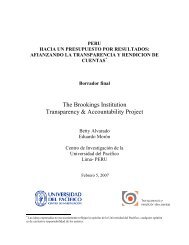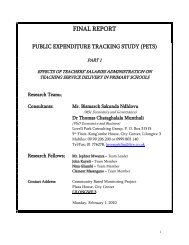Provider Purchasing and Contracting for Health Services_The Case
Provider Purchasing and Contracting for Health Services_The Case
Provider Purchasing and Contracting for Health Services_The Case
Create successful ePaper yourself
Turn your PDF publications into a flip-book with our unique Google optimized e-Paper software.
Zambia’s health delivery system takes a unique approach in terms of inter-linkages required<br />
to help provide the best health services to its population. So far, what is clear is that if fund<br />
holders are given autonomy <strong>and</strong> sufficient funding, there are no serious restrictions on the<br />
modes of contracting as long as particular desired services are provided. This kind of<br />
mechanism, once improved upon, will be able to cater to all classes of people.<br />
Clearly, the modes of contracting on offer within the government, whereby the Ministry of<br />
<strong>Health</strong> subcontracts with its affiliates to provide health services, show the extent to which<br />
contracting-in is easy to establish <strong>and</strong> effect, thereby improving efficiency <strong>and</strong> allocation of<br />
resources. Because the Ministry of <strong>Health</strong> is the main contracting body, it has made it easy to<br />
coordinate services <strong>and</strong> monitor per<strong>for</strong>mance. In this arrangement, it is evident that a<br />
defaulting public contractee is given chance to improve or, where certain capacities are<br />
lacking, interventions have been undertaken to help enhance service delivery. This<br />
arrangement does not call <strong>for</strong> contract termination or penalizing the contractee once default is<br />
established, but correctional activities are instead advocated <strong>and</strong>, where lacking, capacity is<br />
built. <strong>Services</strong> are reviewed <strong>and</strong> improvements suggested.<br />
<strong>The</strong> case of CHAZ has also presented a very pertinent example of how the public sector can<br />
work closely with the private not-<strong>for</strong>-profit sector to enhance health service delivery. As<br />
outlined above, CHAZ’s affiliates are contracted on an institutional basis or through CHAZ<br />
itself. This kind of contracting is unique. <strong>The</strong> government deploys health personnel to CHAZ<br />
affiliates <strong>and</strong> pays <strong>for</strong> the services they provide, instead of CHAZ doing so. This model has<br />
worked well because, where the government has no representation in terms of infrastructure,<br />
CHAZ affiliates have, <strong>and</strong> where CHAZ affiliates lack certain manpower, the government<br />
provides up to 75 percent of the operations grant. This model has also helped outsourcing of<br />
resources where CHAZ affiliates are not restricted to source funds from their churches.<br />
Similarly, the case of CHAZ has also demonstrated that an umbrella structure <strong>and</strong> a buffer<br />
between the government <strong>and</strong> missions is preferable to hierarchical arrangements—allowing<br />
<strong>for</strong> a contractual relationship but independence as well.<br />
As it has been already recognized, the contracting-out of clinical services to private <strong>for</strong>profits<br />
is not common in Zambia. <strong>The</strong>re is a limited amount of contracting-out in laboratory<br />
services. In<strong>for</strong>mally, doctors have made referrals to <strong>and</strong> from public or government/private so<br />
their clients can access some specialized services. A few examples have worked well where<br />
private <strong>for</strong>-profit providers have contracted with each other to provide a particular service.<br />
<strong>The</strong> example of Ronald Ross <strong>and</strong> Malcom Watson Hospitals is a classic case. However, the<br />
original arrangement where these were both government-run facilities <strong>for</strong>ms the backbone<br />
upon which this unique contracting model has worked. This, however, can be replicated<br />
within the private <strong>for</strong>-profit facilities. In addition, the role of private players in health<br />
provision is critical. It is there<strong>for</strong>e important that policymakers adjust <strong>and</strong> accommodate more<br />
roles to be being played by the private <strong>for</strong>-profit organizations.<br />
Partnerships between the government <strong>and</strong> the private sector in the delivery of public health<br />
programs ranging from HIV/AIDs, TB immunizations, <strong>and</strong> malaria prevention have fared<br />
well. Combined with contracting arrangements with mission hospitals, these cases could be<br />
used as a launching pad to integrating the private <strong>for</strong>-profit providers into the health system.<br />
59
















